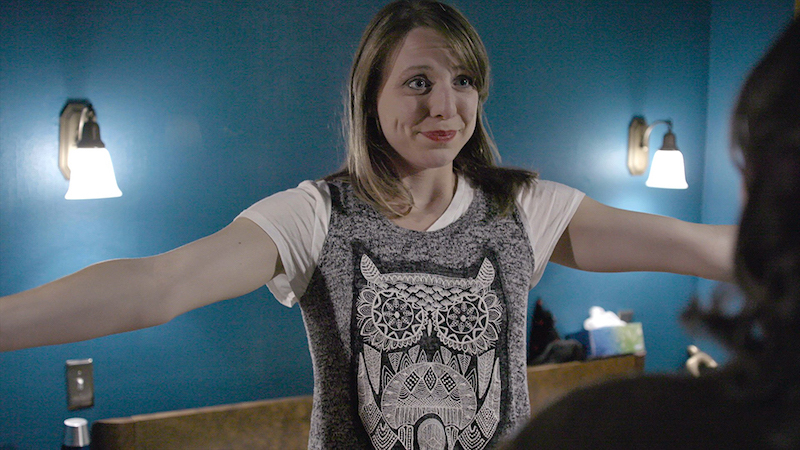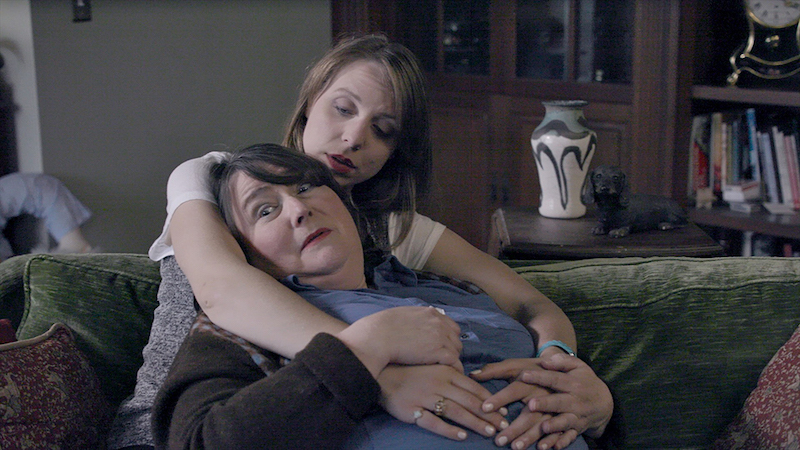The Power of Touch
Review of CUDDLE at SIFF and Northwest Film Forum.
Written by TeenTix Newsroom Writer Vanessa Chen, and edited by Teen Editor Joshua Fernandes!

CUDDLE stars Hope Shanthi as Dina Razzano, an up-and-coming cuddle therapist as she tries to pave the way for a new bold method of therapy. Created by Adeline Colangelo and directed by John Helde, the series follows Dina as she tries to establish her new business while simultaneously discovering herself. Along the way, Dina finds herself facing many who oppose her non-traditional methods including her own brother, Joe Razzano portrayed by Devin Badoo. Each episode chronicles a new experience for Dina and her business, ranging from encountering anxiety ridden clients afraid of intimacy to hunting for an establishment willing to host a cuddle workshop. The series takes an old classic cliche and puts a fun new spin on it through the introduction of cuddle therapy.
The first episode attempts to hook the audience through a classic mother-forces-her-adult son-living-with-her-out-of-his-comfort-zone cliché. Dina just so happens to be caught between pleasing the mother (Patricia Haines-Ainsworth), who lacks a defined sense of personal boundaries, and consoling a lonely son (Ryan Sanders) who lacks social skills. The episode ends with Dina speaking to the camera while reflecting on our ever changing society, even going as far as to comment on society’s increasing loneliness even with new innovative forms of social media that make connecting easier. Colangelo’s commentary on the realities of the society that only seems to be connected while online is effectively communicated in that last scene and certainly a valid concern for the future. Even with all these new forms of technology that allow for us to interact from the comfort of our homes, our society is more disconnected than ever before. Talking to the camera becomes a secondary means for Dina to express her inner thoughts and offer advice to those struggling or feeling lonely, in addition to her usual promotion of the ideals of cuddle therapy. It also becomes a way for the audience to learn the tiniest bit of information about Shanthi’s character, who feels a little half-baked well into the first few episodes.

From the get-go, Dina is clearly defined as a quirky and youthful individual that the audience, as cliché as it sounds, is supposed to fall in love with, but the show doesn’t go much further than that. Although Shanthi does a brilliant job of embodying “quirky” with a big bright smile, there seems to be a lack of character depth and development for Shanthi to continue off of. The audience catches quick glimpses of Dina’s past prior to her move back to Seattle but piecing it all together without any guidance is a near impossible task. Not to say that there aren’t aspects of Dina and her past that are shown, but the only clues are either told directly to the audience or are insufficient at conveying her past, rather than being effectively communicated subtly through artistic direction. One of the few instances of character development being clearly communicated is near the end of the first episode. As the camera pans away and focuses on a happy family setting the table for dinner, Dina narrates, “We’re all looking for the same thing, we just don’t know how to ask for it.” Helde could be suggesting that humans innately desire close, intimate relationships with each other but have a difficult time of articulating and achieving that want. Dina seems to have a good understanding of this; she strives to help others with achieving these intimate relationships through her business.
A later episode depicts a fight between Dina and Joe, the biggest opponent against cuddle therapy thus far, over the location of where Dina’s practice is hosted. Joe gets upset that Dina chooses to have clients over on their property. Lasting a total of 40 seconds and filmed in a single shot, the fight includes so many back and forth switches between the two characters that any attentive audience might get motion sickness. Along the same lines, the cinematography favors a numerous amount of close-ups that overwhelm the viewer with a character’s face taking up well over half the screen, shaky shots that draw audience focus away from what is happening on screen, and unnecessary lingering shots that blur in and out of focus. For example, the beginning of the third episode starts with a shot of Dina moving her head along with the music in her car outside of a client’s house, but as Dina goes to turn off the sound the shots start to go out of focus for the next few seconds. Although in reality the scene is only seven seconds long, it feels a little longer than needed and could have been cut off earlier. Altogether, these qualities add to the growing home movie ambiance of the whole show.

The fundamental idea of CUDDLE—a character trying to find themselves while pursuing their passion—may not be unique, but the plot is. Even though the show is based on an idea as cliché as a character trying to reinvent themselves, cuddle therapy adds a twist. The only problem I find is that the show tries so hard to draw broad abstract claims about commonalities between all humans, especially focusing on desire and loneliness, that it almost deviates from the plot of the show. Colangelo jumps the gun on trying to establish these meta claims, creating a vague and unclear connection between these assertions and the plot of the episode. The show becomes so focused on the themes that it almost feels disconnected from the plot. There’s no doubt that the show has potential to become a grand work of art, but when the plot and its principles feel like puzzle pieces that don’t fit together, it may leave the audience feeling unsatisfied.
Catch the CUDDLE launch party and full series screening on June 27th at Northwest Film Forum!
Photo credits: CUDDLE film stills by director, John Helde.
The Teen Editorial Staff is made up of 5 teens who curate the review portion of the TeenTix blog and manage the TeenTix Newsroom. More information about the Teen Editorial Staff can be found HERE.
The TeenTix Press Corps promotes critical thinking, communication, and information literacy through criticism and journalism practice for teens. For more information about the Press Corps program see HERE.

